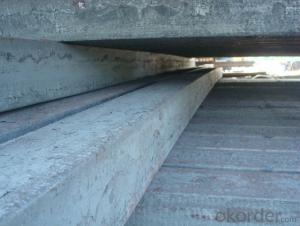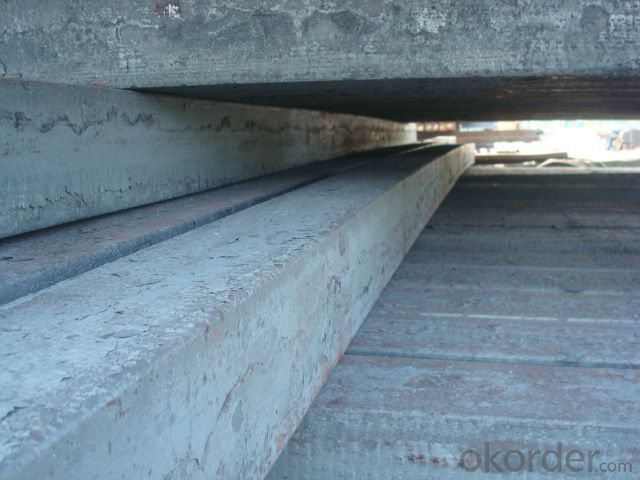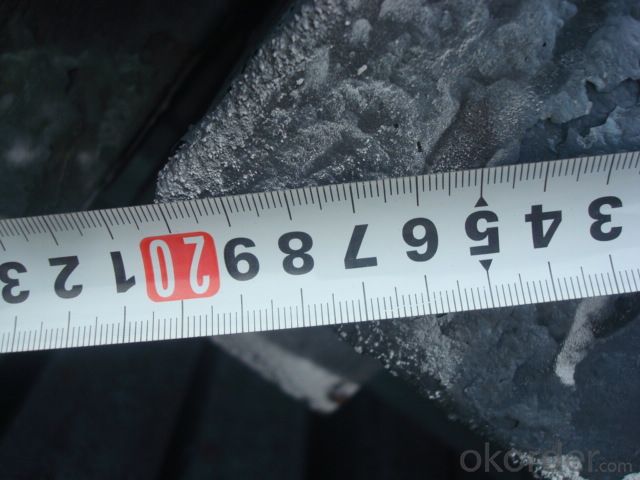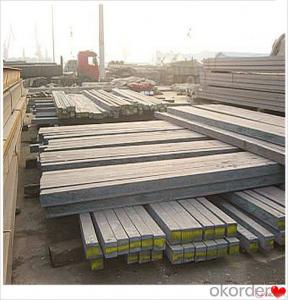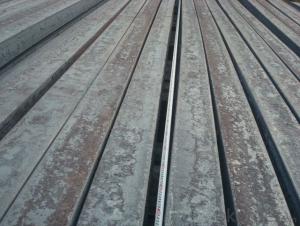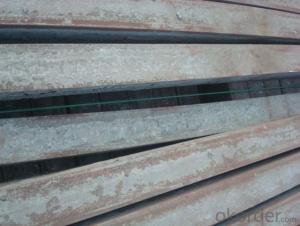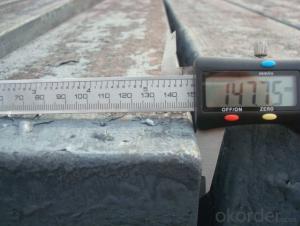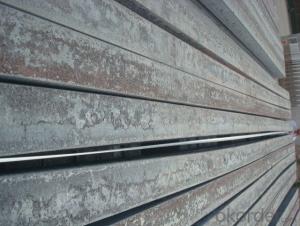Alloyed Steel Billets Manufactured by Continue Casting
- Loading Port:
- Tianjin
- Payment Terms:
- TT OR LC
- Min Order Qty:
- 1000 m.t.
- Supply Capability:
- 10000 m.t./month
OKorder Service Pledge
OKorder Financial Service
You Might Also Like
Alloyed Steel Billets Manufactured by Continue Casting
1.Structure of Alloyed Steel Billets Manufactured by Continue Casting
Steel Billets Manufactured by Continue Casting is the raw material of all kinds of steel mill. Billet section of square, round, flat, rectangular and abnormity, etc Several, mainly related to shape of rolled products. Simple rolled section steel, choose cross section of square billet or rectangular billet. rolling The sector products such as flat steel, Angle steel, select the rectangular billet or slab. Had better profiled billet when production beams, channels, and in rolling process Lines and improve the yield. The raw material of round billet is the production of seamless tube.
2.Main Features of Alloyed Steel Billets Manufactured by Continue Casting.
Steel Billets Manufactured by Continue Casting section size should meet the requirements of rolling deformation and finished product quality, but also roll strength and biting condition of restrictions. General steel Billet section height H. And the roll diameter D The ratio of the ( namely H/D) Should be less than or equal to zero 0.5 . Length of steel billet by finishing temperature, Rolling time and the length of the product Or times ruler. When heated too long accident prone to bump the furnace wall of steel, too short, furnace bottom utilization rate is not high, influence the heating furnace production. For the production Choose a variety of steel and steel billet, should consider the affinities of billet, as far as possible in order to improve the productivity of the roughing mill, simplify the stock management of workshop.
There are three shapes of the steel billets: square billet, slab, rectangular billet The Chinese billet, rectangular billet is mainly suitable for rolling hot rolled strip, building reinforced bar, Ordinary wire, high speed wire rod and various small profile. Of the slab are mainly used for rolling plate and hot coil sheet.
3. Alloyed Steel Billets Manufactured by Continue Casting Images
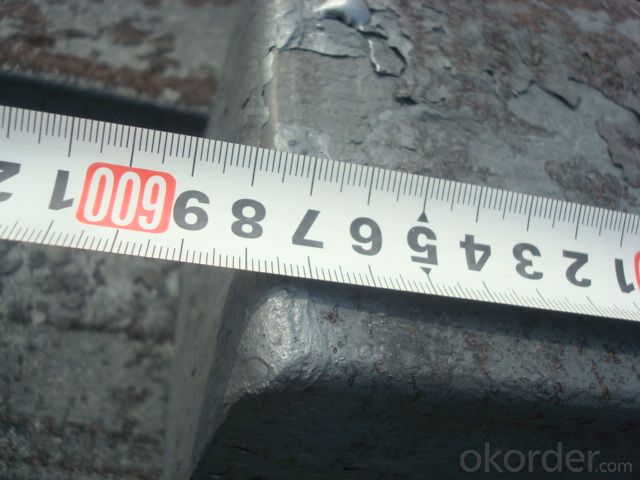
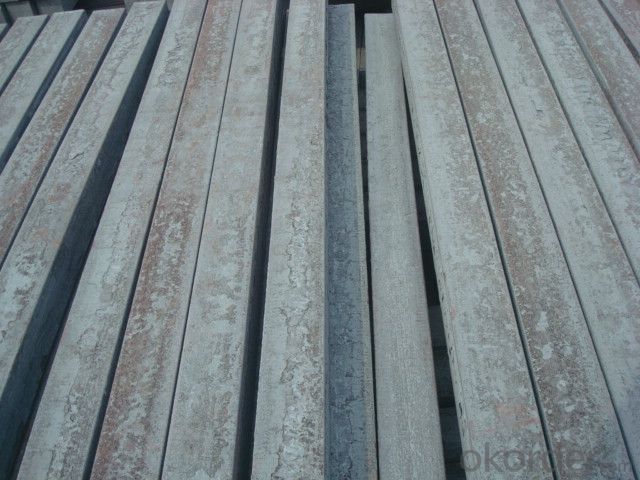
4. Alloyed Steel Billets Manufactured by Continue Casting Specification
Steel Billets Manufactured by Continue Casting rolled steel, after processing can be used for mechanical parts, forging parts, processing all kinds of steel, steel Q345B channel steel, wire rod is the role of the billet. Steel billet is used in the production of semi-finished products, generally cannot be used directly for the society. Steel billets and steel are strictly divided into standard, cannot decide to whether the business enterprise of the final product, and according to unified standards to perform the whole society. Typically, billet and the steel is relatively easy to distinguish, but for some steel billet, and have the same specification and same steel purposes (such as rolling tube billet), whether can be used for other industries, whether through steel processing process, whether through a finished product rolling mill processing to distinguish
Material standard The editor Range of thickness: 150-240 - mm + / - 5 mm width range: 880-1530 - mm + / - 20 mm Length: 3700-10000 - mm + / - 500 - mm Cross-sectional size: 64 * 64; 82 * 82; 98 * 98; 124 * 124; 120 * 150; 152 * 164; 152 * 170 mm Length: 9000 mm Section of tolerance: billet: 1.0 + / - 2.0-1.0 + / - 1.0 mm slab: width: + / - 2.0 mm thickness: + / - 3.0 mm The length tolerance: + / - 200 mm Section diagonal tolerance: 3.5-8.0 MM Billet section size protrusions requirements: < 1242 mm, do not allow; > = 1242 mm, < = 2 mm 1242 mm, < = 3 mm Beheading (shear) extension deformation: < 1242 mm billet: no control; The slab: < = 15 mm Surface tilt: no more than billet section 0.1 Bending: every 1 m length is not more than 10 mm The distortion: length < = 5 m, < = 11. ; The length of the < = 7.5 M, < = 5. Material % 3 sp/PS chemical composition: C Mn Si S P
5.FAQ of Alloyed Steel Billets Manufactured by Continue Casting
We have organized several common questions for our clients,may help you sincerely:
①How about your company?
A world class manufacturer & supplier of castings forging in carbon steel and alloy steel,is one of the large-scale professional investment casting production bases in China,consisting of both casting foundry forging and machining factory. Annually more than 8000 tons Precision casting and forging parts are exported to markets in Europe,America and Japan. OEM casting and forging service available according to customer’s requirements.
②How to guarantee the quality of the products?
We have estaWhat are the types of cracks? Casting billet surface defects is one of the important defects affect the yield and quality of continuous casting machine.According to the statistics, all kinds of defects of cracks accounted for50%.castingCrack of billet, the person that weigh can lead to leakage or scrap, light person to finishing, affect the caster productivity already so,And influenceProduct quality, increase the cost.blished the international advanced quality management system,every link from raw material to final product we have strict quality test;We resolutely put an end to unqualified products flowing into the market. At the same time, we will provide necessary follow-up service assurance.
To analyze the causes of various cracks, the purpose is to study the effects on the crack of the electromagnetic stirring process.Although so far, the academia has not yet been approved electromagnetic stirrer for sure what is the effect of crack, however, some continuous casting experts thought that crystallizer mixer has inhibitory effect on the corner crack of slab, and we, through the study of F - EMS found mixer on the local crack of slab has obvious control action.
③What are the causes of surface longitudinal crack?
Of the nozzle and the mould protection slag melting performance, liquid slag layer is too thick or too thin cause unequal, crystallizer liquid slag filmSurface wave, in steelS + PContent exceeds allowable values, etc. These reasons cause the solidification shell thickness unevenness or make local solidification shell thin easy to crack;Liquid slag layer, the liquid level fluctuation is too thinBig, longitudinal crack increased significantly;S + PExcessive content, significantly lower high temperature performance of steel and plastic, prone to the longitudinal crack.
- Q: How are steel billets used in the manufacturing of slabs?
- Steel billets are an essential raw material used in the manufacturing of slabs. Slabs are large, flat pieces of steel that are used as a primary input in various industries, such as construction, automotive, and manufacturing. To produce slabs, the first step involves obtaining steel billets. These billets are semi-finished steel products that are typically obtained through the continuous casting process or by hot-rolling ingots. They are solid, rectangular or square-shaped blocks of steel with a cross-sectional area that can vary depending on the desired size and thickness of the slabs. Once the steel billets are obtained, they are heated to a high temperature to make them more malleable and easier to shape. This process, known as hot rolling, involves passing the billets through a series of rolling mills to progressively reduce their thickness and increase their length. The rolling mills apply intense pressure to the billets, causing them to elongate and acquire the desired dimensions. During the hot rolling process, the steel billets are often subjected to various manipulations, such as reheating and cooling, to ensure proper shaping and metallurgical properties. The billets may also go through additional processes, such as descaling (removing the oxide layer) and surface treatment, to enhance their quality and finish. Once the hot rolling process is completed, the steel billets are transformed into slabs. These slabs are then further processed to meet specific requirements. For instance, they may undergo additional rolling or reheating processes to achieve the desired thickness, dimensions, and surface finish. The slabs can also be cut into smaller pieces or further processed into different steel products, such as plates, sheets, or coils, depending on the intended use. In summary, steel billets play a crucial role in the manufacturing of slabs. They serve as the starting point for the production process, undergoing hot rolling and other treatments to transform them into the desired shape, size, and quality. The resulting slabs are then used as a primary input in various industries, contributing to the production of a wide range of steel products.
- Q: Can steel billets be used for making architectural components?
- Yes, steel billets can be used for making architectural components. Steel billets are semi-finished products that are typically used to produce various steel products, including architectural components. The billets are heated and then shaped into the desired form using different processes such as forging, extrusion, or rolling. These architectural components can include structural elements like beams, columns, and trusses, as well as decorative elements like handrails, facades, and ornamental fixtures. Steel is a popular choice for architectural components due to its strength, durability, and versatility. It can be easily fabricated into complex shapes, allowing architects and designers to create unique and aesthetically pleasing structures. Additionally, steel offers excellent resistance to weathering, corrosion, and fire, further enhancing its suitability for architectural applications.
- Q: What are the different surface defects in steel billets?
- Steel billets can have various types of surface defects, which can occur during manufacturing or due to handling and transportation. Some common defects include scale, cracks, lamination, pitting, slivers, rolled-in scale, and surface scratches. Scale forms as a rough, flaky coating during heating and rolling, affecting the billet's appearance. Cracks can be caused by improper cooling, excessive pressure, or stress during handling, compromising the billet's strength. Lamination defects occur when non-metallic layers weaken the billet. Pitting is the formation of small cavities due to corrosion or exposure to corrosive environments. Slivers are thin, protruding pieces caused by improper cutting or shearing. Rolled-in scale refers to embedded scale, requiring additional cleaning. Surface scratches are shallow marks that can affect aesthetics and may need further treatment. Proper identification, handling, and treatment of these defects are essential to ensure the quality of the steel billets. Regular inspection and appropriate techniques can minimize defects and enhance the billets' overall quality.
- Q: Are steel billets affected by extreme temperatures?
- Yes, steel billets can be affected by extreme temperatures. High temperatures can cause the billets to soften and become more malleable, making them easier to shape or deform. On the other hand, extremely low temperatures can make the steel brittle and prone to cracking or fracturing. Therefore, it is important to carefully control and monitor the temperature conditions during the production and processing of steel billets.
- Q: How are steel billets cut to size?
- Depending on specific requirements and available equipment, steel billets can be cut to size using various methods. Sawing or shearing is a common technique, offering precision and accuracy. This can be done manually or with automated machinery. For thicker billets or intricate shapes, flame cutting is often used. This method involves melting and severing the steel with a high-temperature flame. Similarly, plasma cutting is a popular option. It utilizes a high-velocity jet of ionized gas to melt and cut through the steel, providing smoother edges and a more precise cut. Water jet cutting is another possibility, suitable for materials sensitive to heat or for achieving intricate shapes. It involves using a high-pressure jet of water mixed with an abrasive material. In some cases, laser cutting technology is employed. This method uses a laser beam to heat and melt the steel, allowing for precise and efficient cutting. Laser cutting is preferred for its ability to handle various thicknesses and complex shapes. Ultimately, the choice of cutting method for steel billets depends on factors such as desired precision, billet thickness, shape complexity, and available equipment.
- Q: How can steel billets be customized for specific applications?
- Steel billets can be customized for specific applications through various processes such as heat treatment, alloying, and shaping. Heat treatment techniques like quenching and tempering can enhance the billet's strength, hardness, and toughness. Alloying elements can be added to improve specific properties like corrosion resistance or high-temperature performance. Additionally, the billets can be shaped through processes like rolling, forging, or extrusion to achieve the desired dimensions and form required for specific applications.
- Q: What are the common uses of steel billets?
- Steel billets are semi-finished metal products that serve as a precursor to various steel products. They are typically produced through the process of continuous casting or hot rolling, resulting in a solid, rectangular shape. Due to their versatility and strength, steel billets have numerous common uses across various industries. One of the primary applications of steel billets is in the production of long steel products such as bars, rods, and wires. These billets serve as the starting material for further processing, where they are reheated and shaped into the desired form. Long steel products find extensive use in construction, infrastructure development, manufacturing, and transportation industries. Steel billets are also utilized in the production of seamless pipes and tubes. By subjecting the billets to the process of piercing and elongation, they can be transformed into seamless tubes that are widely used in oil and gas exploration, automotive manufacturing, and structural engineering. Furthermore, steel billets play a crucial role in the production of forged steel components. Forging involves shaping the heated billet through the application of pressure, resulting in high-strength and durable products. These forged components are widely used in industries such as aerospace, automotive, and power generation. In addition to these applications, steel billets are also used in the production of various other steel products like beams, channels, and profiles for construction purposes, as well as in the manufacturing of machine parts and tools. Overall, the common uses of steel billets can be summarized as the starting material for the production of long steel products, seamless pipes, forged components, and other steel products. Their versatility, strength, and malleability make steel billets an essential raw material in numerous industries.
- Q: What is the chemical composition of steel billets?
- Steel billets are primarily composed of iron, with varying amounts of carbon and other alloying elements such as manganese, silicon, and trace amounts of sulfur and phosphorus.
- Q: What are the main factors affecting the magnetic properties of steel billets?
- The main factors affecting the magnetic properties of steel billets are the composition of the steel, the crystal structure, the presence of impurities, and the manufacturing process used.
- Q: What are the different types of steel billet heat treatment processes?
- There are several types of steel billet heat treatment processes that are commonly used in the industry. These processes aim to improve the mechanical properties of the steel billets, such as strength, hardness, toughness, and ductility, to meet specific application requirements. Some of the different types of steel billet heat treatment processes include: 1. Annealing: This process involves heating the steel billet to a specific temperature and then slowly cooling it to room temperature. Annealing helps to relieve internal stresses and improve the machinability and ductility of the steel. 2. Normalizing: In this process, the steel billet is heated to a temperature above its critical point and then allowed to cool in still air. Normalizing refines the grain structure of the steel, resulting in improved mechanical properties and uniformity. 3. Quenching: Quenching involves rapidly cooling the steel billet from a high temperature by immersing it in a quenching medium, such as water, oil, or polymer. This process creates a hardened structure in the steel, increasing its hardness and strength. 4. Tempering: After quenching, the steel billet is heated to a lower temperature and then cooled slowly. Tempering reduces the brittleness caused by quenching and improves the toughness, ductility, and machinability of the steel. 5. Austempering: This process involves quenching the steel billet to a temperature just above the martensite transformation range and holding it at that temperature until it transforms to bainite. Austempering results in a structure with improved strength, toughness, and wear resistance. 6. Martempering: Martempering is similar to austempering, but the steel billet is quenched into a medium at a temperature slightly above the martensite transformation range and then held until it cools to below that temperature. This process produces a structure with improved toughness and reduced distortion compared to conventional quenching. These are just a few of the many heat treatment processes used for steel billets. The choice of process depends on the desired mechanical properties and application requirements of the steel.
Send your message to us
Alloyed Steel Billets Manufactured by Continue Casting
- Loading Port:
- Tianjin
- Payment Terms:
- TT OR LC
- Min Order Qty:
- 1000 m.t.
- Supply Capability:
- 10000 m.t./month
OKorder Service Pledge
OKorder Financial Service
Similar products
Hot products
Hot Searches
Related keywords
